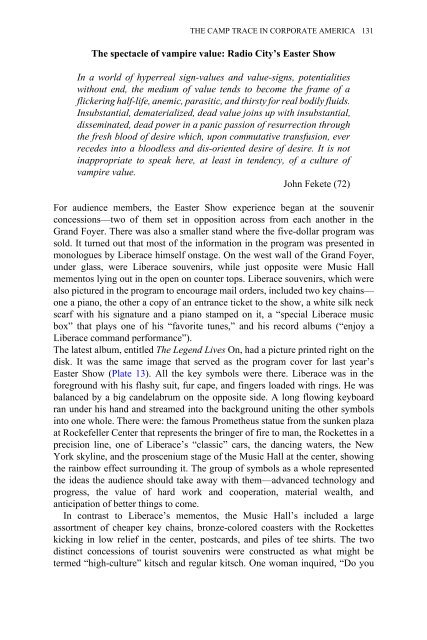Edited by Moe Meyer - Get a Free Blog
Edited by Moe Meyer - Get a Free Blog
Edited by Moe Meyer - Get a Free Blog
Create successful ePaper yourself
Turn your PDF publications into a flip-book with our unique Google optimized e-Paper software.
THE CAMP TRACE IN CORPORATE AMERICA 131<br />
The spectacle of vampire value: Radio City’s Easter Show<br />
In a world of hyperreal sign-values and value-signs, potentialities<br />
without end, the medium of value tends to become the frame of a<br />
flickering half-life, anemic, parasitic, and thirsty for real bodily fluids.<br />
Insubstantial, dematerialized, dead value joins up with insubstantial,<br />
disseminated, dead power in a panic passion of resurrection through<br />
the fresh blood of desire which, upon commutative transfusion, ever<br />
recedes into a bloodless and dis-oriented desire of desire. It is not<br />
inappropriate to speak here, at least in tendency, of a culture of<br />
vampire value.<br />
John Fekete (72)<br />
For audience members, the Easter Show experience began at the souvenir<br />
concessions—two of them set in opposition across from each another in the<br />
Grand Foyer. There was also a smaller stand where the five-dollar program was<br />
sold. It turned out that most of the information in the program was presented in<br />
monologues <strong>by</strong> Liberace himself onstage. On the west wall of the Grand Foyer,<br />
under glass, were Liberace souvenirs, while just opposite were Music Hall<br />
mementos lying out in the open on counter tops. Liberace souvenirs, which were<br />
also pictured in the program to encourage mail orders, included two key chains—<br />
one a piano, the other a copy of an entrance ticket to the show, a white silk neck<br />
scarf with his signature and a piano stamped on it, a “special Liberace music<br />
box” that plays one of his “favorite tunes,” and his record albums (“enjoy a<br />
Liberace command performance”).<br />
The latest album, entitled The Legend Lives On, had a picture printed right on the<br />
disk. It was the same image that served as the program cover for last year’s<br />
Easter Show (Plate 13). All the key symbols were there. Liberace was in the<br />
foreground with his flashy suit, fur cape, and fingers loaded with rings. He was<br />
balanced <strong>by</strong> a big candelabrum on the opposite side. A long flowing keyboard<br />
ran under his hand and streamed into the background uniting the other symbols<br />
into one whole. There were: the famous Prometheus statue from the sunken plaza<br />
at Rockefeller Center that represents the bringer of fire to man, the Rockettes in a<br />
precision line, one of Liberace’s “classic” cars, the dancing waters, the New<br />
York skyline, and the proscenium stage of the Music Hall at the center, showing<br />
the rainbow effect surrounding it. The group of symbols as a whole represented<br />
the ideas the audience should take away with them—advanced technology and<br />
progress, the value of hard work and cooperation, material wealth, and<br />
anticipation of better things to come.<br />
In contrast to Liberace’s mementos, the Music Hall’s included a large<br />
assortment of cheaper key chains, bronze-colored coasters with the Rockettes<br />
kicking in low relief in the center, postcards, and piles of tee shirts. The two<br />
distinct concessions of tourist souvenirs were constructed as what might be<br />
termed “high-culture” kitsch and regular kitsch. One woman inquired, “Do you


